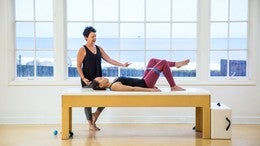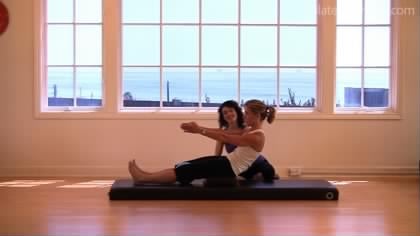Description
About This Video
Transcript
Read Full Transcript
Hi everyone. I'm here today to talk about knees. And if you're like me, uh, with a little knee issue that kind of comes and goes from time to time. Let's just take a quick 15 minutes or so to talk about it. So if you're in class, if you're student watching classes on plotting anytime or taking class anywhere and you're having knee pain or discomfort, don't ignore that, but don't be so afraid of it, but don't ignore it. Well, let's talk about it and some strategies around some conditioning. And if you're a new teacher out there, um, and you have clients in classes or um, people in your studio, in your classes that are talking about knee pain or discomfort and you're not really sure what to do, some of this might help you today. So I'm going to show you my normal leg alignment. Don't be afraid.
I'm going to stand up. I'm putting myself on the hot seat here. Okay. I am a hyper extender of my knees. So take a good look from my knees, basically mid thigh to my ankle joints and just look at me from the front. You know, and you can use your assessment at home or whatever, but just look at the alignment. You're going to see some interesting things and I am not trying to fix it right now at all. Okay? That's what you see. Now I'm going to turn this way.
I'm going to turn all the way around so you can see all angles of my, my leg alignment. So there I am standing. I want you to really pay attention and look at the back of my knees, right? And I'll turn around and you can see the back of my knees. But look at the alignment from knee to ankle. All right? And then I'll do one more vantage point.
And you may say something different there. You might even be able to, from this point be able to see the back of my knee from that angle. I'm not sure that's how hyper extended I am, but okay, so I'm not judging myself. What I am saying is I have some interesting muscle development that's not balanced in my lower extremity. So on my calf I have more muscle development out here, lateral side. Then I do my medial side.
So over time that has sheared my knee a little to the right and worn down, um, my knee joint. Okay? Some of it is hereditary, but that's another story. But here's one strategy. Okay? I'm going to get to the point. So I'm going to have, watch what I do. I'm going to put my foot forward for me to get some sensation in my calf muscles. I want to take one hand on my shin there and spiral or rotate or twist my skin and my muscle tissue. I'm going to come down a little bit more like this. Okay?
So because I have more development here, I want to get some sensation here. What if I do that? And it feels really good to me actually just holding my skin that way. Now when I bear weight on that, it's hard to see, I think. But you can kind of see there's more round shape and more evenness from medial to lateral side. Let me undo it. You, you can see more less, right?
[inaudible] is about muscular development and balance of our physique and our s our body. So wouldn't it be interesting to do that? So I'm gonna hold my Catholic that and just put some pressure on my big toe joint, which yes is a Bunyan and I'm just going to rock back and forth a little bit. So that tiny bit of weight shift, this is so lovely. I can feel my calf contracting in my hand. So I want to do more of that. So that's one little sure fire way for me to work some knee conditioning on my own. And this is a weird body posture that I'm in.
So can I keep it while I stand? It's harder to keep my calf spiraled like that. Okay. So knee health, it's what's below the knee and it's also what's above the knee that matters. So we want support from below. We want support for some poor support from above, specifically medial line here and hamstrings. Okay.
So the other thing I want to show you here, and if you're a new teacher and you're having clients talk about their knee pain, you may want to ask them to do this and just have a look or you yourself. So I will do the my, if Amy straightens her knee completely, that's it. See how my heels popped up off the mat. I've overextended the back of my knee, I've pushed it back like I did when I was standing right? So that's not doing me any good.
So to avoid that disruption in my knee alignment, I want to set my heel down and I need to do some contraction for above my knee, but I'm not super strong right here. So I need something for some feedback to talk into that musculature. So I like to roll up a towel or fold the towel, support the back of my knee. Oh my God. Feel so good, right? I like to use my hands and I'm going to touch my own leg on the medial side, lateral side and try to taught the muscles, contract them. I also liked the word stiffen. I like to stiffen my knee with my heel, press down, stiff in the knee.
You should feel some response in the tissue, in your body here. Right? And now I'm going to act as if act as if I'll drag my heel backward. Not really going too, but the act as if already started to make some contraction happen right here in the leg. I'm actually feeling it all the way up my hip too. Okay. You could also lightly press your knee down on the towel. Here's one more with the towel hand on your Shin.
This is an odd one as if you're pressing your shin up into your hand. Not a lot of action, but certainly from my body messaging to that is I'm thinking of resisting and pulling my Shin Up. Okay. What's happening? I feel more contraction here and that's what we're after. Those types of ways to support that knee. Okay. So if you're at home and your knee person, try these out.
I also have a couple on the reformer, so those are coming next. But um, eventually you won't need the prop. Okay. The other prop I have here on the table is a yoga, a beanbag o r sandbag, and that's amazing. It's a little bit bigger. Same kind of idea. So if you're somebody that has it, a bean bag like that, so I'm not pushing down, I'm pushing down my heel and I'm trying to think of resist pulling my shinbone up. Right. But see if I take that out, it's a better straight leg. Can you see that versus over straight. Okay, now that's what that is. Alrighty. So stay tuned with me. I'm going to come back. I'm going to bring the reformer out and show you just two things on the reform that we can do to finish my little list of 15 minutes of better knees. Okay.
We're back with the reformer and what I'd like to talk about here just briefly is a work around for the, the often done exercise, feet in straps, like legs down, up, hips or legs, circles and things like that. If you're hyper extender and your legs are straight up in the air and the straps on the foot, very likely you might be overextending and pulling those springs right and all that pressure behind your knees. I've got a great work around for that, but first we want to isolate like I was mentioning just a moment ago, the the muscles below the knee. So we've got our calves and muscles above the knee. There's lots of them. But this little exercise here is kind of specific for this medial part right there. VMO, if you like the name and all the way up to the inner thigh, let's just call it the inner thigh. Okay, so you'll need a ball, a pillow roll up your towel, something like that. I've got three red springs on.
You want something kind of on the heavier side? Um, neat balls, a few down the bar, a little bit pitched inward, slight internal rotation. You can see my in my foot angle there with my feet. Now the ball is way up high by the knees. Some exercises, we put it lower in there. Don't do that. Please put it way up high because I want you to isolate the muscles closer to the ball, so right where that ball is on your body. Okay? Press and hold it. You are going to feel right in here. This is important.
Now push the carriage back a little bit. I'm not going to do anything full extension of the knee. You're going to see me just hold this position for quite a while. For the purpose of this tutorial, I won't hold it for as long as I would if I'm at home doing my rehab for myself. You know a minute or two, honestly, just hold it. This is called isometric.
So isometric. You're in a contraction without moving. It's stationary. Okay. This is like mind to muscle moment. My calves are active. I can make them more active. I have to think about it. It's the weight in those big toe joints. Again, just like it had myself a moment ago. Now I feel my calves more. Okay. I'm starting to quiver.
This is good and I'm really feeling this interline and muscle. Now I've gotten awake. They're active for me. They're ready. I'm going to move them now, press the ball and do a little come in toward the bumper. A little push out. Pull in, push out. Stay mind to muscle right here where you're touching that ball, okay? And the balls of the feet on the bar. Now we can up the tempo.
You see us do these little pulses a lot in class. Sometimes with the ball, sometimes not. Wow, I'm getting nice and tired in here, alright? But sometimes knee problems are because this is weak. Let's just be honest. And these are overworked and stronger. That's just the truth. So let's be aware of that. Let's be truthful, honest, and let's work that muscle area a little bit more often. Okay? Let's have healthier knees on and on.
So you could go for a while. I would say do this as until you can't, until you just simply cannot do one more repetition. But I'm going to move on because there's one more really, really good one. Oh my gosh, my legs feel good. So take your straps. We are not putting the feed in here, okay? But I do need you to push away. Put your whole foot through it and put it right above the back of the knee, not the back of the knee, above the back of the knee. Different, right?
And then the other one, like you're stepping into a big pair of boots. Okay, because as I was making my point about leg circles, if your legs are fully straight, Ooh, I'm going to be a little mindful. Ah, if I were to pull on these straps right now, I would not feel good behind the knees. It's just too much pressure. We are still on three red springs. So what I want to do is let you fold your knees down. Let Your Shins Hane, press your knees together, Flex your feet. Okay, so pull your thighs down away from your chest.
That's hip extension. What muscles are involved? Is the back of the legs also extremely important for knee health. All right? And then bring them back up. That's some stomach. Flex your feet, push down, point your feet, pull out. That's your tummy. Also, you're so az and flex to pull down. Opening, closing at the hip joints. Let's continue about three more.
When you bring your legs away from you and that hip extension, you have to really can tract your hamstring muscles. What I'm thinking for myself is that I'm trying to pull this skin up, the back of my leg toward my hipbones. Drag that skin up the back of the leg. That's the contraction. So your, the ropes are shaking. That's how much I'm working. It's so good and up. That was a better one. Okay, so I'm going to move on into circles. So open up your knees, let your feet pull, get it pulled apart. Take your time.
We did a lot of contraction in here. This is going to stretch this area. You need that balance of contraction and stretch and then bring your legs together. So that's how you can do leg circles. You don't have to do with feet, arm straps or straps on your feet. You can do it behind your knees. So it looks like this down open. That's what everyone else in class would be doing with their legs straight. If you're a new teacher, you can actually have your whole class do this before you even put the feet and straps exercise because by that time when they get the feed and straps, they'll actually know how to contract their hamstrings and not over pull the back of the knee. Kind of a fun idea.
I wish I would have learned that when I was a lot younger in my [inaudible] practice. Okay. And of course the converse, you going to go the other way? Flex the feet down and um, we'll do about five. So if you're out there doing this with me, I hope you're feeling some additional sensation in the muscles behind your legs, around your knees. Certainly felt the inner line. If you're just watching and taking notes, feel free to ask me more questions if you want to in the forum. Because I am a knee person, I have knee injuries pop up often and little setbacks, but I'm not going when they haven't been too bad. All right?
But I know that I have to kind of keep up with these little prehab rehab exercises to keep myself healthy. And I like to dance and I like to hike and I like to do things that sometimes put the knees and a little stressful angle and pressure. I don't want to give up those things, but I can rely on my pull out east practice to really help me keep that condition. So hope you got something out of this. Let me know. I'll see you next time guys.
The Successful Beginner - Playlist 2: Modifications for Classes
Comments
You need to be a subscriber to post a comment.
Please Log In or Create an Account to start your free trial.






























